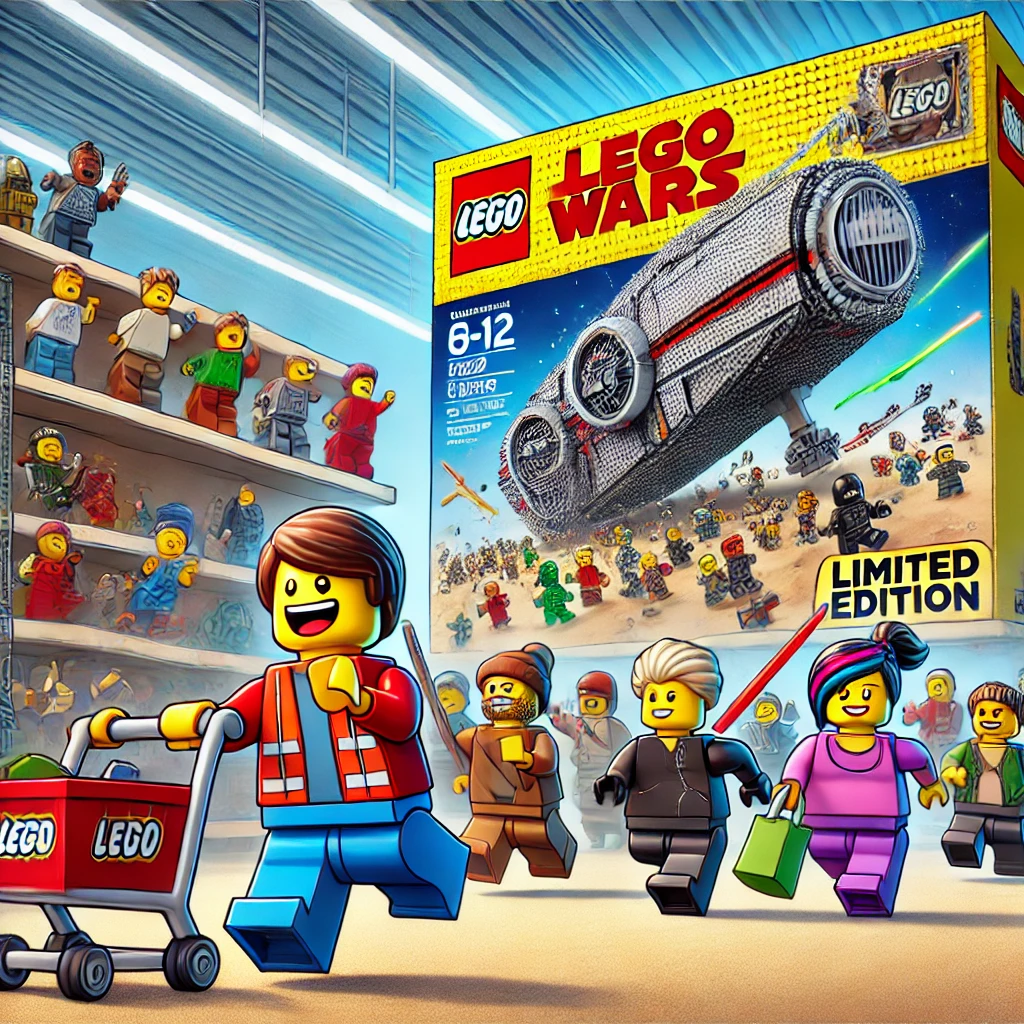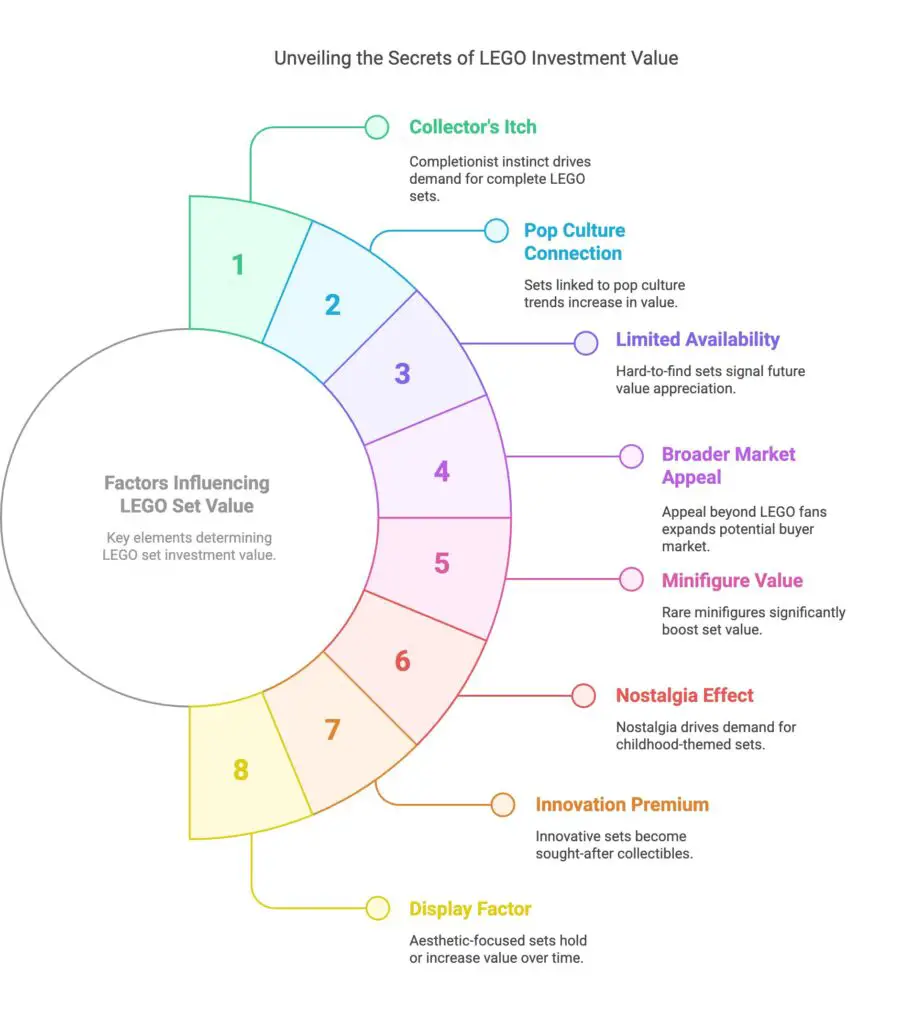
Ever wondered why some LEGO sets gather dust in bargain bins while others become holy grails worth hundreds or even thousands of dollars? The answer lies in understanding demand – the invisible force that turns plastic bricks into gold.
Why Some LEGO Sets Become Treasure Chests
Let’s face it: LEGO investing isn’t just about buying random sets and hoping for the best. The smartest investors know exactly what signals to watch for. Think of these as your treasure map to LEGO gold!
The Five Magic Ingredients of a Valuable LEGO Set
1. The Collector’s Itch
We’ve all felt it – that nagging feeling when you have four out of five sets in a series. It’s like having a puzzle with one piece missing! Sets that are part of a collection trigger this completionist instinct in fans.
For example, those Speed Champions cars might seem modest individually, but try having just a few and not wanting the whole garage! Same goes for the Harry Potter Hogwarts Moment books – who wants an incomplete library? When a set makes collectors think “I need the whole set,” you’ve found investment potential.
Fun fact: Some LEGO collectors have been known to purchase multiple copies of the same set – one to build, one to display sealed, and one to sell years later!
2. The Pop Culture Connection
Remember when everyone suddenly wanted the LEGO Stranger Things Upside Down set in 2022? That wasn’t random – it coincided perfectly with a surge in the show’s popularity.
Smart LEGO investors think like entertainment industry analysts. Is that Marvel set connected to an upcoming movie? Is that video game theme about to get a sequel? The deeper a set’s hooks into popular culture, the longer it stays relevant – and valuable.
Did you know? The LEGO Star Wars Ultimate Collector Series Millennium Falcon has increased in value by over 400% since its original release, largely due to the enduring popularity of the franchise!
3. Flying Off the Shelves
A set that’s hard to find even when it’s officially available is giving you a major clue about its future value. While LEGO keeps its actual sales figures secret (sneaky!), there are ways to crack the code.
Check Amazon’s Best Seller Rank, count those online reviews, or even use Google Trends to see which sets people are searching for. If a set is consistently sold out or ranking better than its peers, that’s your bat-signal!
Insider tip: During holiday seasons, monitor which sets LEGO limits per customer on their official store – this is often a sign of anticipated high demand and potential future value.
4. Beyond the Brick Fanatics
Some of the most valuable LEGO sets appeal to people who’ve never browsed a LEGO forum or subscribed to a brick YouTube channel. The Botanical Collection? It’s in the homes of plant lovers and interior design enthusiasts who might not own any other LEGO sets.
Architecture skylines end up on office desks of people who visited those cities. Car enthusiasts who don’t build other LEGO sets proudly display perfect replicas of their dream vehicles.
When a set has appeal beyond traditional LEGO fans, it taps into an entirely different market – and that means more potential buyers down the road.
Interesting development: Interior designers have increasingly begun incorporating LEGO botanical sets into their professional design schemes, introducing these sets to clients who would never have considered LEGO before!
5. The Minifigure Factor
Never underestimate the power of a tiny plastic person! Some sets become valuable almost entirely because of the minifigures inside. That exclusive Star Wars character or uniquely printed superhero can sometimes be worth more than the entire set they came in.
The same goes for rare parts – special molds, unique colors, or pieces that never appeared in other sets create their own mini economy. Some builders will pay premium prices just to get their hands on these elements.
Surprising fact: Some rare minifigures have sold for over $1,000 individually – more than many complete LEGO sets!
Beyond the Basics: Additional Factors Driving LEGO Demand
6. The Nostalgia Effect
There’s a fascinating pattern where LEGO sets often experience their highest appreciation 15-20 years after release. Why? That’s when the kids who wanted these sets but couldn’t afford them grow up and enter their peak earning years. The generation who grew up watching the original Star Wars trilogy drove prices of early Star Wars sets skyward in the 2000s. Similarly, today’s 30-somethings are behind the surging prices of Harry Potter and Lord of the Rings sets from their childhoods.
This nostalgia cycle is remarkably predictable. Keep an eye on what today’s children are obsessed with – those themes will likely see resurgent demand when these kids become adults with disposable income.
7. The Innovation Premium
Sets that introduce groundbreaking building techniques or revolutionary parts often become landmarks in LEGO history. The first Technic sets with pneumatic functions, the introduction of minifigure-scale trains, or the debut of new joint systems for better articulation – these innovations become reference points for collectors.
The LEGO Ideas Ship in a Bottle set exemplifies this perfectly: it showcased novel techniques to create the illusion of water inside a transparent vessel, something never done before at that scale. Innovation creates conversation, and conversation drives awareness and demand.

8. The Display Factor
Sets designed specifically to be displayed rather than played with tend to hold or increase their value dramatically. Adult-oriented sets that focus on aesthetics over playability – like the Architecture series, botanical sets, or art pieces like the Warhol and Van Gogh tributes – have strong appeal as home decor that transcends typical toy categorization.
The display factor is why “coffee table LEGO sets” command premium prices. They’re conversation starters in homes and offices, serving a dual purpose that traditional toys rarely achieve.
9. The Retirement Rush
LEGO’s production model creates a fascinating economic dynamic. When a set’s retirement is announced or rumored, there’s often a sudden surge in demand as collectors rush to acquire it before retail availability ends. This creates a self-fulfilling prophecy where anticipation of value increase actually causes that increase to happen.
Savvy investors monitor the “Last Chance to Buy” section of the LEGO website religiously, as this final warning often triggers the beginning of a set’s appreciation curve.
10. The Authenticity Appeal
In our increasingly digital world, physical collectibles offer tangible satisfaction that virtual goods cannot. LEGO’s commitment to quality and the tactile joy of building creates an authenticity premium. Unlike digital collectibles, physical LEGO sets can’t be duplicated with a click – each one represents real materials, engineering, and manufacturing.
This authenticity factor becomes even more valuable in a world where more entertainment and collecting goes digital. The physical nature of LEGO creates scarcity that digital items struggle to replicate.
The Psychology Behind LEGO Investing
What makes LEGO particularly fascinating as an investment is how it combines rational and emotional drivers. The rational side includes limited production runs, predictable retirement cycles, and quality that ensures longevity. But equally powerful are the emotional aspects: nostalgia, the joy of completion, and the social status of owning rare sets.
This emotional component stabilizes LEGO investments during economic downturns. When traditional markets falter, emotional investments often hold steady because their value isn’t tied solely to financial metrics but to human connection and meaning.
Putting It All Together
The real magic happens when you find sets that tick multiple boxes. A collectible set with popular minifigures tied to a resurgent franchise that appeals to non-LEGO fans and keeps selling out? That’s not just a good investment – that’s a retirement plan!
Next time you’re eyeing a LEGO set as a potential investment, look beyond the colorful box and piece count. Analyze these demand signals, consider the psychological drivers, and you’ll start spotting tomorrow’s valuable sets before they disappear from shelves.
Remember, successful LEGO investing isn’t about luck – it’s about recognizing patterns and understanding what drives people’s desire for these colorful little bricks long after they’ve left store shelves.
Happy investing, and may your LEGO portfolios always build upward!
Imagine Your Dream Side Income Becoming A Reality
Picture yourself confidently selecting LEGO sets that others walk right past, knowing exactly which ones will multiply in value while they collect dust in attics elsewhere. This isn’t just about buying plastic bricks—it’s about building your financial future, one carefully chosen set at a time. In “Winning Set Secrets,” I’ve created the roadmap I wish I’d had when I started my LEGO investment journey. You’ll transform from uncertain collector to confident investor, armed with the exact framework that’s helped me and countless others build wealth through LEGO.
No more second-guessing or missed opportunities—just strategic decisions backed by proven principles. If you’re ready to stop wondering which sets might be valuable someday and start knowing with certainty which ones will be, click below to secure your copy of “Winning Set Secrets” and join the community of investors who see LEGO for what it truly is: not just toys, but tomorrow’s treasures.
